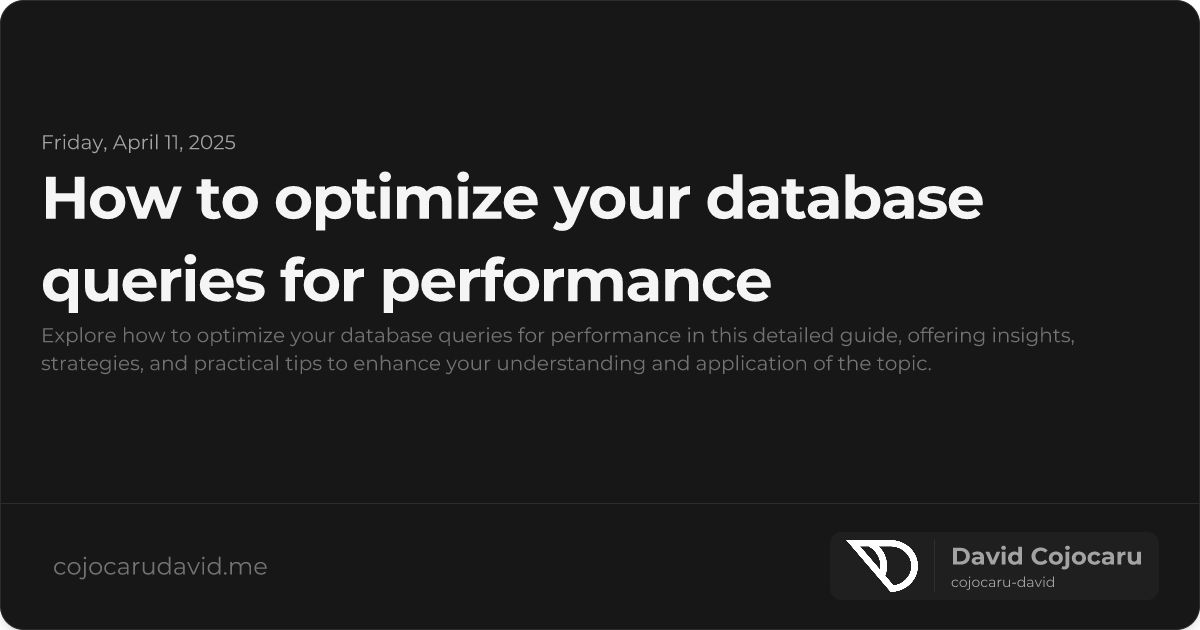Supercharge Your App: A Guide to Database Query Optimization
Database performance is the linchpin of any application demanding rapid and efficient data retrieval. Whether you’re navigating the intricacies of MySQL, PostgreSQL, or NoSQL databases, mastering database query optimization is paramount for slashing latency and delivering a seamless user experience. This guide unveils practical techniques to fine-tune your queries, from strategic indexing to ingenious query refactoring, ensuring your database operates at peak performance.
Why Query Optimization is Non-Negotiable
Sluggish queries can cripple your application, leading to disgruntled users and inflated server costs. Optimizing your queries delivers a cascade of benefits:
- Lightning-Fast Response Times: Users get the data they need, when they need it.
- Reduced Server Strain: Less work for your servers means they can handle more.
- Enhanced Scalability: Your application gracefully handles growing data volumes and user traffic.
- Lower Operational Expenses: Optimized queries translate to reduced resource consumption.
By embracing these best practices, you ensure sustained high performance, even as your dataset expands.
Key Strategies for Database Query Optimization
1. Strategic Indexing: Your Data’s Fast Lane
Indexes act as data directories, enabling the database to pinpoint records without a full table scan. However, excessive indexing can impede write operations.
- Judiciously Add Indexes: Target frequently queried columns (e.g.,
user_id,created_at,product_id). - Avoid Indexing Low-Selectivity Columns: Steer clear of indexing columns with limited unique values (e.g., boolean
is_activefields) – they offer minimal performance gains. - Leverage Composite Indexes: Create indexes spanning multiple columns for queries that filter on those columns simultaneously. Order matters: place the most selective column first.
Example:
CREATE INDEX idx_user_email ON users(email);2. Crafting Optimized Query Structures
Poorly constructed queries can squander processing power. Adhere to these guidelines for streamlined efficiency:
- Embrace Column Specificity: Instead of
SELECT *, retrieve only the columns you need. This reduces data transfer and processing overhead. - Refactor Nested Queries: Where possible, replace nested queries (subqueries) with joins for better performance.
- Harness the Power of
EXPLAIN: UseEXPLAINto dissect query execution plans and identify bottlenecks. Analyze the output to understand how the database is retrieving data and identify areas for optimization.
Example:
EXPLAIN SELECT name, email FROM users WHERE status = 'active';3. Limit and Paginate: Master Data Delivery
Fetching massive datasets in one go can cripple the database. Employ these techniques for efficient data delivery:
- Employ
LIMIT: Restrict the number of rows returned using theLIMITclause. - Implement Pagination: Divide large result sets into manageable pages.
- Consider Lazy Loading: Load data on demand, only when it’s needed.
Example:
SELECT * FROM orders WHERE user_id = 100 LIMIT 10 OFFSET 20;4. Eliminate Full Table Scans: The Enemy of Efficiency
Full table scans force the database to examine every row, even if only a few match. Prevent them by:
- Ensuring Adequate Indexing: Add indexes to columns used in
WHEREclauses. - Refining
WHEREClauses: Craft preciseWHEREclauses that leverage indexes. - Partitioning Large Tables: If necessary, divide massive tables into smaller, more manageable partitions.
5. Caching: Your Shortcut to Speed
Repeatedly querying the same data wastes precious resources. Implement caching strategies:
- Database-Level Caching: Employ in-memory data stores like Redis or Memcached for caching frequently accessed data.
- Application-Level Caching: Cache results of common queries within your application code.
- Query Result Caching: For read-heavy workloads, cache the results of specific queries.
Advanced Optimization Techniques
1. Normalization and Denormalization: A Delicate Balance
- Normalization: Minimizes data redundancy but can increase the complexity of joins.
- Denormalization: Enhances read performance at the expense of increased storage and potential data inconsistencies.
Strike the optimal balance based on your specific application needs and workload.
2. Optimizing Joins: Mastering Data Relationships
Joins can be resource-intensive. Enhance their performance by:
- Utilizing Indexed Columns: Ensure the columns used in join conditions are indexed.
- Avoiding Unnecessary Joins: Only join tables when absolutely necessary.
- Preferring
INNER JOIN: Opt forINNER JOINoverOUTER JOINwhen possible, as they are generally more efficient.
Example:
SELECT u.name, o.total
FROM users u
INNER JOIN orders o ON u.id = o.user_id;3. Continuous Monitoring and Tuning: The Key to Sustained Performance
Regularly monitor your database performance using:
- Query Logs: Analyze query logs to identify slow-running queries.
- Database Profiling Tools: Employ profiling tools (e.g., MySQL’s
SHOW PROFILE) to pinpoint performance bottlenecks. - Automated Monitoring: Set up automated monitoring systems to detect performance regressions and anomalies.
Conclusion
Mastering database query optimization is indispensable for crafting scalable, high-performance applications. By strategically applying indexing, refining query structures, and leveraging caching, you can dramatically improve efficiency. Continuously monitor and adapt your strategies to maintain peak performance, ensuring your application remains responsive and efficient.
“A well-optimized database is the bedrock of a responsive application. Never underestimate the transformative impact of a lightning-fast query.”

